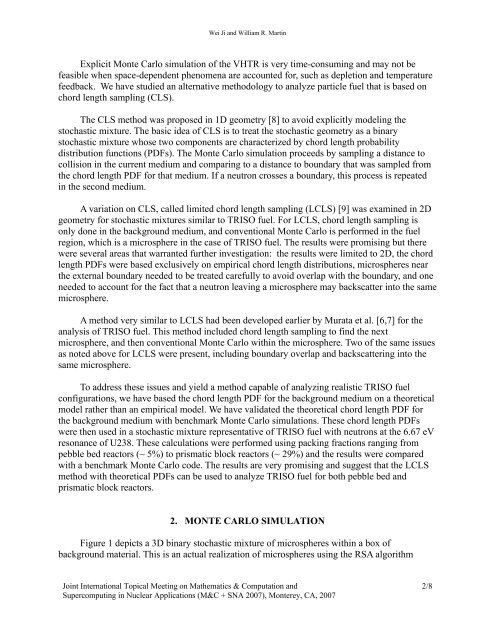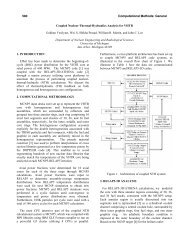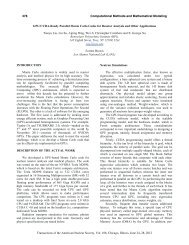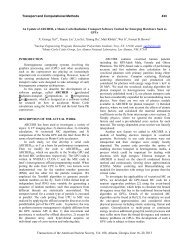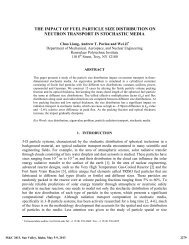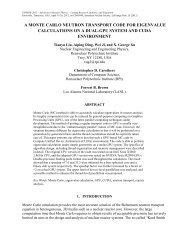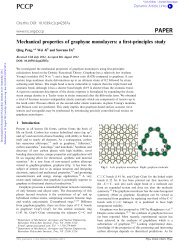Monte Carlo Simulation of VHTR Particle Fuel with Chord Length ...
Monte Carlo Simulation of VHTR Particle Fuel with Chord Length ...
Monte Carlo Simulation of VHTR Particle Fuel with Chord Length ...
Create successful ePaper yourself
Turn your PDF publications into a flip-book with our unique Google optimized e-Paper software.
Wei Ji and William R. Martin<br />
Explicit <strong>Monte</strong> <strong>Carlo</strong> simulation <strong>of</strong> the <strong>VHTR</strong> is very time-consuming and may not be<br />
feasible when space-dependent phenomena are accounted for, such as depletion and temperature<br />
feedback. We have studied an alternative methodology to analyze particle fuel that is based on<br />
chord length sampling (CLS).<br />
The CLS method was proposed in 1D geometry [8] to avoid explicitly modeling the<br />
stochastic mixture. The basic idea <strong>of</strong> CLS is to treat the stochastic geometry as a binary<br />
stochastic mixture whose two components are characterized by chord length probability<br />
distribution functions (PDFs). The <strong>Monte</strong> <strong>Carlo</strong> simulation proceeds by sampling a distance to<br />
collision in the current medium and comparing to a distance to boundary that was sampled from<br />
the chord length PDF for that medium. If a neutron crosses a boundary, this process is repeated<br />
in the second medium.<br />
A variation on CLS, called limited chord length sampling (LCLS) [9] was examined in 2D<br />
geometry for stochastic mixtures similar to TRISO fuel. For LCLS, chord length sampling is<br />
only done in the background medium, and conventional <strong>Monte</strong> <strong>Carlo</strong> is performed in the fuel<br />
region, which is a microsphere in the case <strong>of</strong> TRISO fuel. The results were promising but there<br />
were several areas that warranted further investigation: the results were limited to 2D, the chord<br />
length PDFs were based exclusively on empirical chord length distributions, microspheres near<br />
the external boundary needed to be treated carefully to avoid overlap <strong>with</strong> the boundary, and one<br />
needed to account for the fact that a neutron leaving a microsphere may backscatter into the same<br />
microsphere.<br />
A method very similar to LCLS had been developed earlier by Murata et al. [6,7] for the<br />
analysis <strong>of</strong> TRISO fuel. This method included chord length sampling to find the next<br />
microsphere, and then conventional <strong>Monte</strong> <strong>Carlo</strong> <strong>with</strong>in the microsphere. Two <strong>of</strong> the same issues<br />
as noted above for LCLS were present, including boundary overlap and backscattering into the<br />
same microsphere.<br />
To address these issues and yield a method capable <strong>of</strong> analyzing realistic TRISO fuel<br />
configurations, we have based the chord length PDF for the background medium on a theoretical<br />
model rather than an empirical model. We have validated the theoretical chord length PDF for<br />
the background medium <strong>with</strong> benchmark <strong>Monte</strong> <strong>Carlo</strong> simulations. These chord length PDFs<br />
were then used in a stochastic mixture representative <strong>of</strong> TRISO fuel <strong>with</strong> neutrons at the 6.67 eV<br />
resonance <strong>of</strong> U238. These calculations were performed using packing fractions ranging from<br />
pebble bed reactors (~ 5%) to prismatic block reactors (~ 29%) and the results were compared<br />
<strong>with</strong> a benchmark <strong>Monte</strong> <strong>Carlo</strong> code. The results are very promising and suggest that the LCLS<br />
method <strong>with</strong> theoretical PDFs can be used to analyze TRISO fuel for both pebble bed and<br />
prismatic block reactors.<br />
2. MONTE CARLO SIMULATION<br />
Figure 1 depicts a 3D binary stochastic mixture <strong>of</strong> microspheres <strong>with</strong>in a box <strong>of</strong><br />
background material. This is an actual realization <strong>of</strong> microspheres using the RSA algorithm<br />
Joint International Topical Meeting on Mathematics & Computation and 2/8<br />
Supercomputing in Nuclear Applications (M&C + SNA 2007), <strong>Monte</strong>rey, CA, 2007


